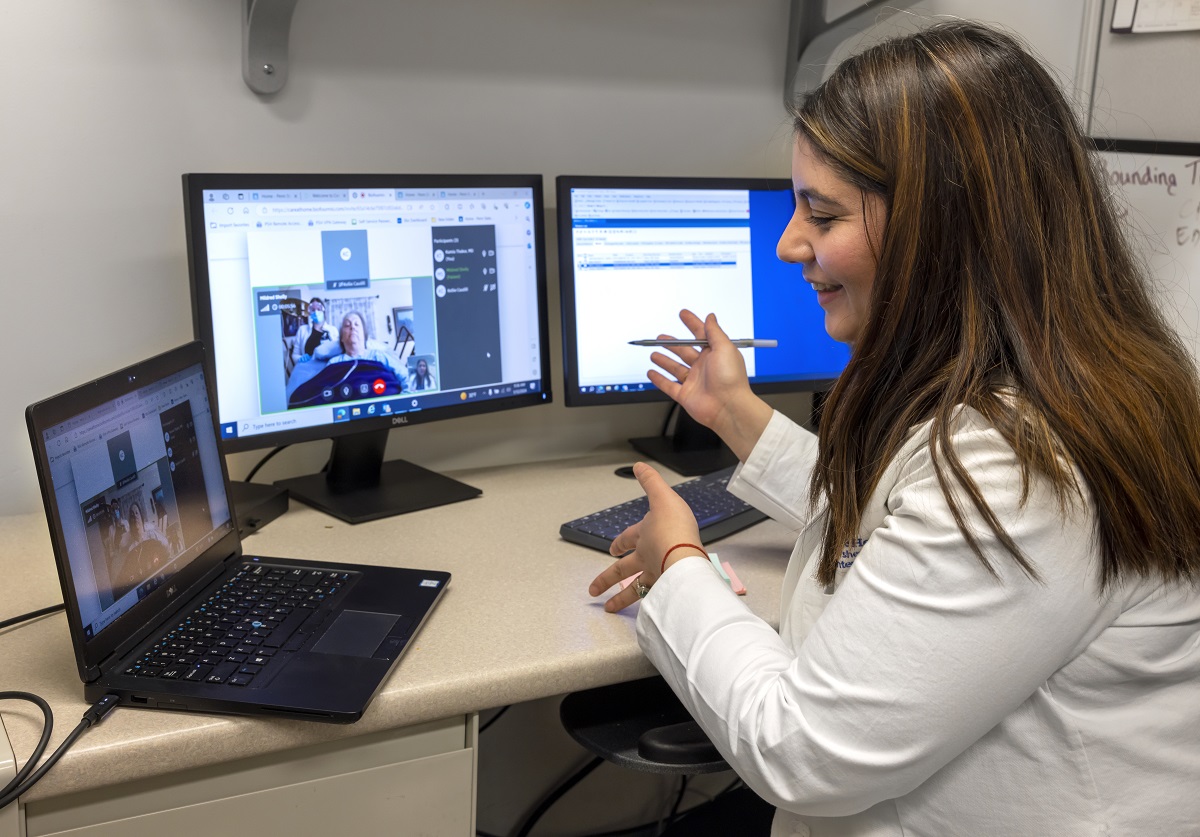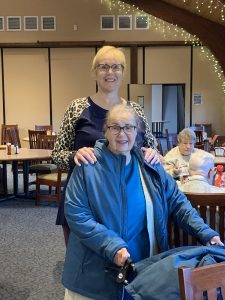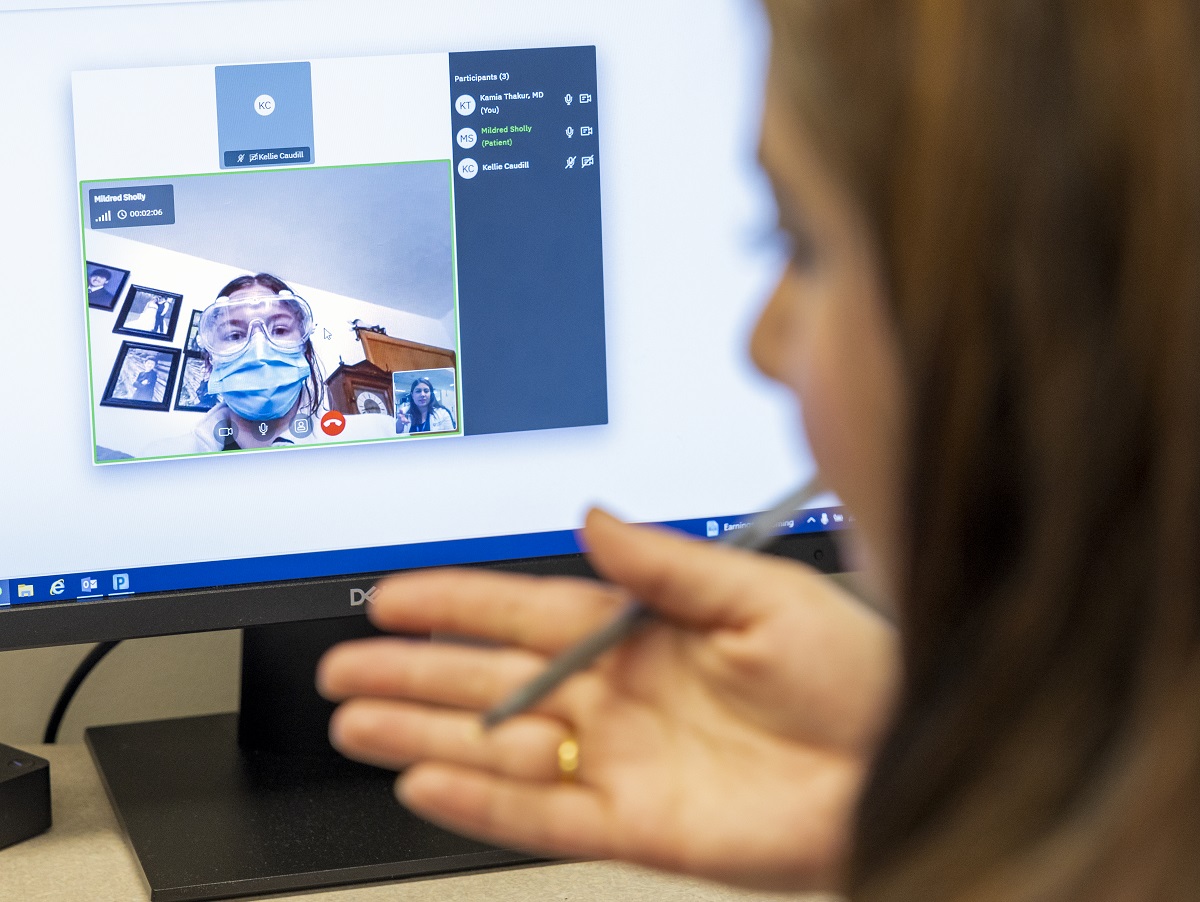Take the hospital home: Program allows people to recover in their own beds

Florence Gordon, who spent her career as a nurse at a hospital in Reading, was dreading what looked like a long bout as an inpatient when she went to Penn State Health Milton S. Hershey Medical Center in the summer of 2023 with pneumonia.
Not that Florence and her primary caregiver – her daughter Joy – had an aversion to hospitals. Joy followed in her mother’s footsteps and works as a nurse in pediatric perianesthesia at the very hospital she brought Florence. Throughout their careers, both women had become well-versed in how simple kindnesses from someone in scrubs can make the darkest moments of a patient’s life a shade brighter.
But ever since suffering two strokes, Florence just prefers home. “She’s much more mobile there,” Joy said. She knows the terrain and can keep up with her daily routines.
As it turns out, her doctors agreed. To both the mother’s and daughter’s surprise, the medical team at Milton S. Hershey Medical Center asked Florence if she wanted to go home – and take the hospital with her.
“We were like, ‘Duh, yeah,’” Joy said.
Gordon qualified for the Penn State Health Home Recovery Care program, which was created in 2021 through a partnership with Highmark Health and Contessa, a Nashville-based company that specializes in home recovery care. Since then, about 280 Milton S. Hershey Medical Center patients who, like Gordon, fit specific criteria, have done their recuperating at their homes. And they’ve gotten better without sacrificing regular, in-person care from nurses, daily consultations from doctors, medicine and technical equipment.
The program’s medical director, Dr. Kamia Thakur, says studies show patients who convalesce at home often have better results than those who recover in hospitals.
For example, a 2021 study by the National Institutes of Health found that at-home care patients had a 26% lower risk for readmission. The same study found patients recovering at home had less depression and anxiety scores than people receiving in-hospital care.
The Home Recovery Care program’s benefits reach even further than the families who qualify. During a time when emergency departments everywhere face longer wait times and overcrowding,
the ripple effects of the Home Recovery Care program has made more space available at the hospital to administer emergency care faster to patients who need it.
A candidate for going home
Gordon arrived at the hospital one evening at about midnight, and 12 hours later she went home. Doctors chose her as a candidate for the Home Recovery Care program because she hadn’t been admitted to intensive care and wouldn’t need any surgical procedures during her stay.
She also lives about 14 miles away from the hospital in in Cornwall, Lebanon County. That fits another qualification ― all Home Recovery Care patients must live within 30 miles of Milton S. Hershey Medical Center.
The program isn’t for everyone. You can’t walk into Milton S. Hershey Medical Center and ask to enroll. Every day, a health care team reviews inpatients and determines the best candidates. Then, they ask the patients if they’d like to opt in. Most do.
Florence was ready to go home. It had taken two strokes to slow her down. Joy towers over her mother, but for those who know her, Florence is a giant force to be reckoned with, Joy said. “A feisty little Mennonite woman,” Joy describes her, who brought up her daughter to “fear the force of mom.”
When stroke one came calling, Florence went back to helping plan community dinners and writing birthday and holiday cards to shut-ins.
Stroke two took a bigger toll. Today, Florence’s memory isn’t quite what it was. Still, Florence reads her Bible faithfully, takes short walks around the neighborhood with her daughter and participates in her card ministry. She has a routine of crossword puzzles and a new pastime – DrumFIT, a cardiovascular workout where Florence uses drumsticks to wale on an inflatable exercise ball perched in a hamper with drumsticks.
An extended hospital stay might have taken her out of her routine. That’s why when the offer came to go home, the two leapt at it.
Good for patients, good for doctors
Florence needed an oxygen supply to help her breathe. So, when she arrived at home, a team from Penn State Health set up the machine to help her breathe in her room.
From IV machines to vital signs monitors with feeds that appear on computer screens in the hospital to wheelchairs and ambulatory equipment, Home Recovery Care provides patients with everything they need to help them feel well again.
State and federal regulatory agencies require the hospital to ensure patients at home receive care of at least the same quality as they’d receive in the hospital, Thakur said.
Like all participants in the program, nurses came to see Florence two times a day. Roughly 10 nurses from Milton S. Hershey Medical Center work on a rotating basis making house calls to Home Recovery Care patients.
During their house calls, nurses administer medicine, check vitals and offer emotional support. They take blood for lab analysis and can even perform ultrasounds and X-rays.
Along with medical gear for their recovery, patients receive a computer tablet that allows them to speak to doctors using telehealth video conferencing.
Both the at-home visits and the video conferencing enhance patient care in ways hospital stays can’t, Thakur said. At-home health care workers can witness day-to-day lives in ways they never could in a hospital room. They can see firsthand patients’ medicine-taking habits, what they eat for dinner and other aspects of home life that affect their health.
Video conferencing also fosters more individualized attention, Thakur said. Several physicians at any given time make the Home Recovery Care rounds on a rotating basis. Each doctor takes a turn covering a full week talking with patients on video screens in a conference room.
Making their in-person rounds through emergency department beds, doctors may spend five or 10 minutes speaking with a patient. Consultations over the video screens sometimes last as long as 30 minutes.
The trade-off, of course, is physical contact, Thakur said. Doctors often use their sense of touch to administer care. But the longer appointments are luxury, Thakur said. She has more time to get to know her patients better in the Home Recovery Care program.
Still the force of mom
Joy was surprised how well her mother was taken care of. Nurses came and went two times a day. Eventually, they weaned Florence off oxygen, and her symptoms faded.
Before long, she was back to walking, writing her cards, reading her Bible and tapping out crazy rhythms on her exercise ball for her DrumFIT routines.
Joy had worried a weeklong stay in the hospital might have been another setback. Instead, Florence is still “the force of mom.”
“It was phenomenal,” Joy said.
If you're having trouble accessing this content, or would like it in another format, please email Penn State Health Marketing & Communications.


